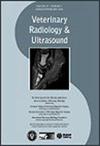Classification of the quality of canine and feline ventrodorsal and dorsoventral thoracic radiographs through machine learning
IF 1.3
2区 农林科学
Q2 VETERINARY SCIENCES
引用次数: 0
Abstract
Thoracic radiographs are an essential diagnostic tool in companion animal medicine and are frequently used as a part of routine workups in patients presenting for coughing, respiratory distress, cardiovascular diseases, and for staging of neoplasia. Quality control is a critical aspect of radiology practice in preventing misdiagnosis and ensuring consistent, accurate, and reliable diagnostic imaging. Implementing an effective quality control procedure in radiology can impact patient outcomes, facilitate clinical decision‐making, and decrease healthcare costs. In this study, a machine learning‐based quality classification model is suggested for canine and feline thoracic radiographs captured in both ventrodorsal and dorsoventral positions. The problem of quality classification was divided into collimation, positioning, and exposure, and then an automatic classification method was proposed for each based on deep learning and machine learning. We utilized a dataset of 899 radiographs of dogs and cats. Evaluations using fivefold cross‐validation resulted in an F1 score and AUC score of 91.33 (95% CI: 88.37–94.29) and 91.10 (95% CI: 88.16–94.03), respectively. Results indicated that the proposed automatic quality classification has the potential to be implemented in radiology clinics to improve radiograph quality and reduce nondiagnostic images.通过机器学习对犬科和猫科动物腹背和背腹部胸片的质量进行分类
胸片是伴侣动物医学中必不可少的诊断工具,常用于对因咳嗽、呼吸困难、心血管疾病和肿瘤分期而就诊的患者进行常规检查。质量控制是放射学实践中防止误诊和确保成像诊断一致、准确和可靠的关键环节。在放射学中实施有效的质量控制程序可以影响患者的治疗效果,促进临床决策,降低医疗成本。本研究提出了一种基于机器学习的质量分类模型,适用于以腹背位和背腹位拍摄的犬科和猫科胸片。质量分类问题分为准直、定位和曝光,然后提出了基于深度学习和机器学习的自动分类方法。我们使用了一个包含 899 张猫狗照片的数据集。使用五倍交叉验证进行评估后,F1 分数和 AUC 分数分别为 91.33(95% CI:88.37-94.29)和 91.10(95% CI:88.16-94.03)。结果表明,所提出的自动质量分类有可能在放射科临床中实施,以提高射线照片质量,减少非诊断图像。
本文章由计算机程序翻译,如有差异,请以英文原文为准。
求助全文
约1分钟内获得全文
求助全文
来源期刊

Veterinary Radiology & Ultrasound
农林科学-兽医学
CiteScore
2.40
自引率
17.60%
发文量
133
审稿时长
8-16 weeks
期刊介绍:
Veterinary Radiology & Ultrasound is a bimonthly, international, peer-reviewed, research journal devoted to the fields of veterinary diagnostic imaging and radiation oncology. Established in 1958, it is owned by the American College of Veterinary Radiology and is also the official journal for six affiliate veterinary organizations. Veterinary Radiology & Ultrasound is represented on the International Committee of Medical Journal Editors, World Association of Medical Editors, and Committee on Publication Ethics.
The mission of Veterinary Radiology & Ultrasound is to serve as a leading resource for high quality articles that advance scientific knowledge and standards of clinical practice in the areas of veterinary diagnostic radiology, computed tomography, magnetic resonance imaging, ultrasonography, nuclear imaging, radiation oncology, and interventional radiology. Manuscript types include original investigations, imaging diagnosis reports, review articles, editorials and letters to the Editor. Acceptance criteria include originality, significance, quality, reader interest, composition and adherence to author guidelines.
 求助内容:
求助内容: 应助结果提醒方式:
应助结果提醒方式:


